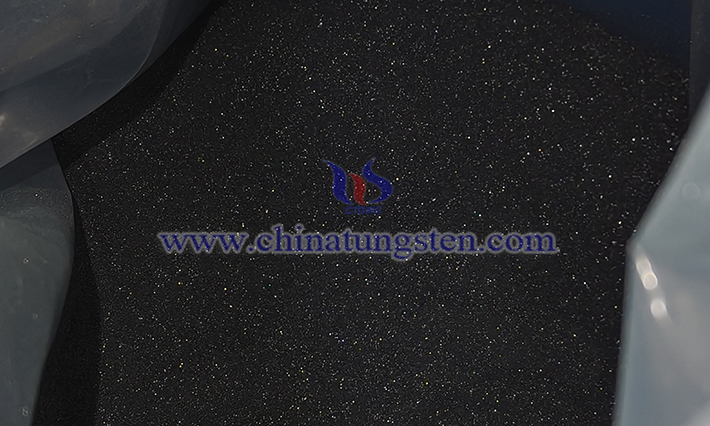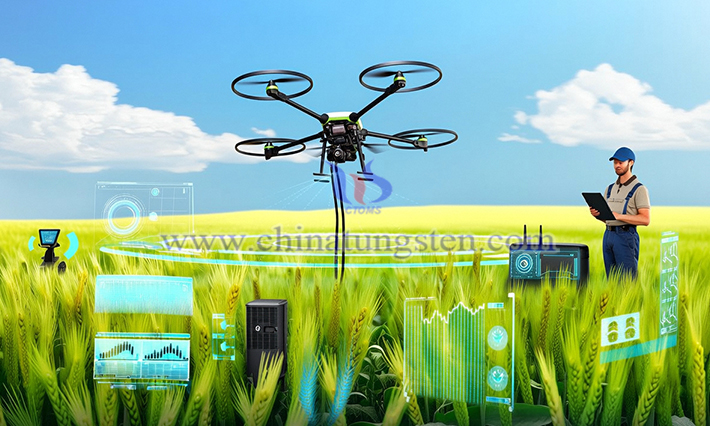Tungsten: The "Invisible Cultivator" of the Smart Agriculture Era
- Details
- Category: Tungsten's News
- Published on Friday, 25 April 2025 17:37
In a smart farm in China, unmanned rice transplanters shuttle through the fields with centimeter-level precision, drones equipped with high-precision navigation systems perform plant protection operations, and intelligent seedling nurseries achieve precise seedling cultivation through environmental control systems. In this agricultural revolution driven by technology, a metal element called tungsten is playing multiple roles, from wear-resistant components in agricultural machinery to additives in smart agricultural films, from sensor materials to AI hardware support. Tungsten is becoming an indispensable "invisible cultivator" in the smart agriculture industry chain.

The "Diamond Armor" of Agricultural Machinery
In the process of agricultural mechanization, the wear resistance of agricultural machinery components has always been a key factor limiting efficiency. Tungsten carbide, a compound of tungsten and carbon, boasts a hardness comparable to diamond. When sprayed onto the surfaces of easily worn components such as plowshares and deep loosening shovels, it forms a dense wear-resistant coating. In practical applications, agricultural machinery components utilizing tungsten carbide spraying technology exhibit significantly longer field operation life compared to traditional steel components. Maintenance intervals are greatly extended, directly reducing the total lifecycle cost of agricultural machinery.
The "Light and Heat Manager" of Smart Agricultural Films
The application of blue tungsten oxide agricultural films in greenhouses showcases unique advantages. The addition of this dark blue powder transforms traditional agricultural films from mere coverings into intelligent environmental regulation systems. Blue tungsten oxide offers excellent acid and alkali resistance as well as heat resistance, significantly enhancing the film’s anti-aging properties and extending its service life. More importantly, its distinctive electromagnetic wave absorption properties enable the film to effectively absorb near-infrared rays under intense midday sunlight, maintaining stable temperatures inside the greenhouse. On cloudy days, it ensures high transmittance of visible light, supporting normal photosynthesis. This intelligent regulation creates a more suitable light and heat environment for crop growth.

The "Neural Tentacles" of Smart Systems
The precision of agricultural sensors determines the "perceptual dimensions" of smart agriculture. Micro-nano probes made from tungsten-rhenium alloy can accurately capture changes in crop leaf transpiration, while photoelectric sensors doped with tungstate monitor soil heavy metal ion concentrations in real time. Data from these sensors is processed by edge computing nodes and ultimately fed into the agricultural AI brain. Particularly noteworthy is the stability of tungsten-based materials in extreme environments, enabling high data collection integrity rates for permafrost monitoring sensors in Northeast China’s black soil and drought warning systems in Xinjiang’s cotton fields. This reliability provides a solid foundation for precision agriculture.
The "Material Engine" of Industrial Transformation
According to Dongxing Securities, by 2025, the market size of China’s smart agriculture industry is projected to reach 150 billion yuan, with agricultural AI decision-making systems achieving a compound annual growth rate of 47.8%. On this promising trajectory, the tungsten industry is seizing an opportunity for value reconstruction. The application of tungsten-based materials is driving agricultural equipment from mere "mechanization" to "material intelligence," generating value-added potential exceeding 1,000 yuan per mu (approximately 0.165 acres) of cultivated land.
From agricultural machinery laboratories along the English Channel to smart greenhouses on the Loess Plateau, tungsten is writing a new chapter in modern agriculture. When the agricultural AI brain processes trillions of data points from tungsten-based sensors, and machinery with tungsten carbide coatings works tirelessly on the black soil, this metal element transcends the realm of traditional industrial materials. It serves as a bridge connecting the atomic world with digital agriculture. In this quiet industrial revolution, tungsten leverages its unique physical properties to inject "hardcore" power into global food security.
- Chinatungsten Online: www.chinatungsten.com
- CTIA GROUP LTD: en.ctia.group
- Tungsten News & Price: www.ctia.com.cn
- Molybdenum News & Price: news.molybdenum.com.cn
- Tel.: 86 592 5129696; Email: sales@chinatungsten.com